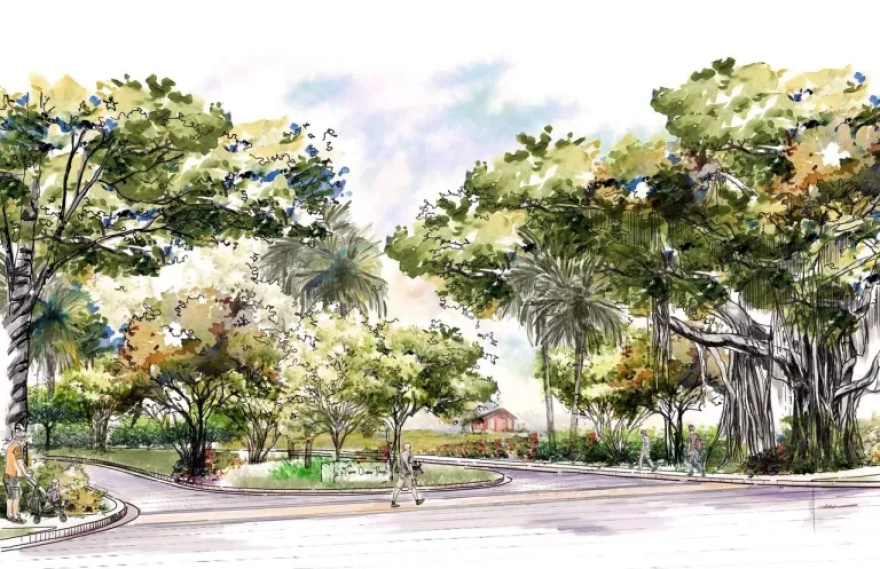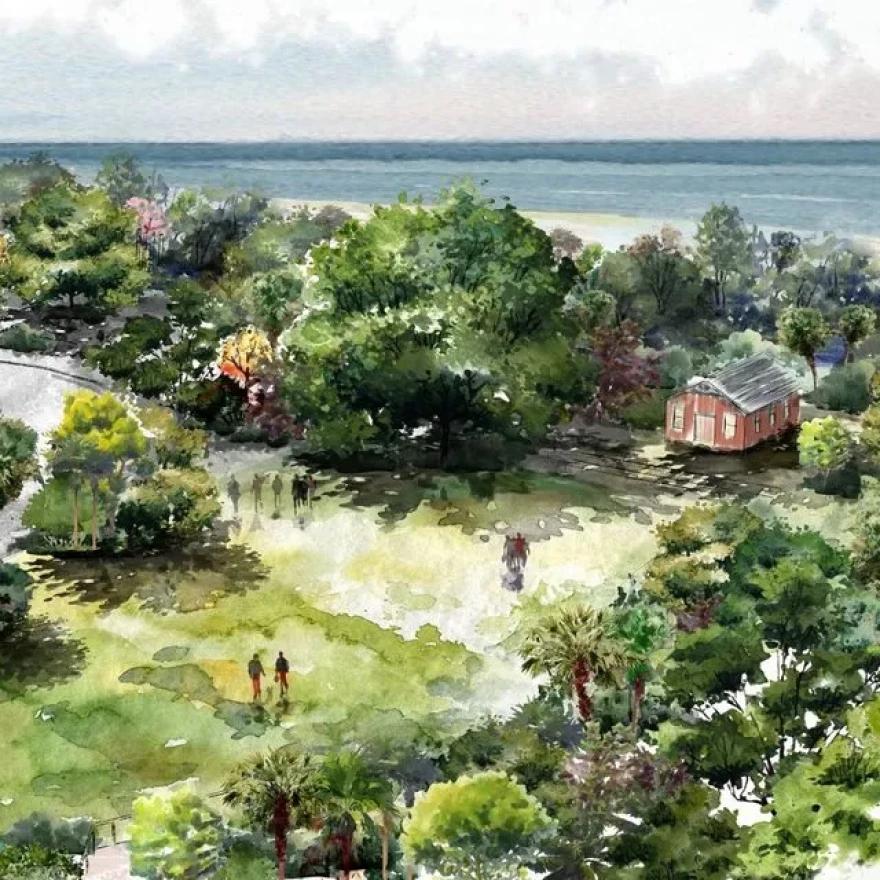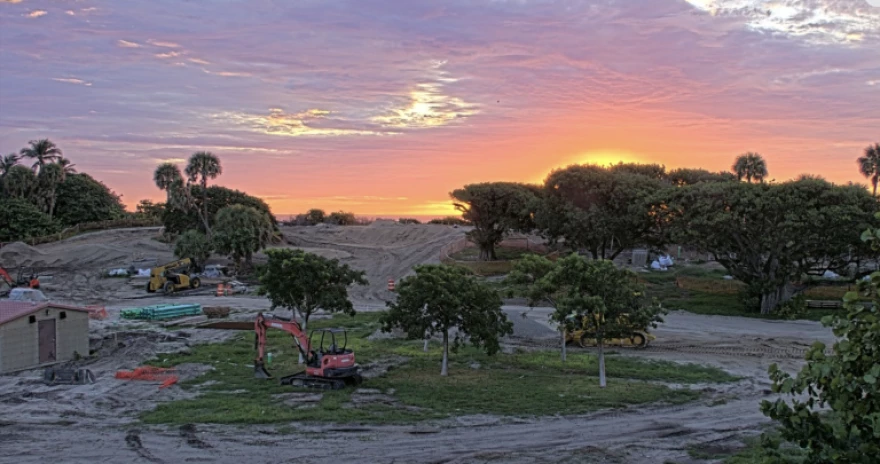A $31 million renovation promises to bring new life to Palm Beach’s oceanfront park.
When the updated tennis facilities opened at Phipps Ocean Park on Nov. 1, it marked a milestone, the completion of the first phase of the 18-acre park’s renovation.
Phases will include dune restoration and the addition or relocation of 80,000 native plants, moving the oldest schoolhouse in Southeast Florida and adding a plant educational center.
Other updates include new beach pavilions, a lifeguard tower, restrooms and benches and picnic tables throughout the public park.
The park, owned by Palm Beach, closed May 1 to improve the tennis courts and add two pickleball courts to meet rising demand. The refurbishing will keep the rest of the park and the beach closed for 12 months.
Three miles south of Mar-a-Lago, the ocean-to-intracoastal land was given to the town in 1948 by the family of Henry Phipps Jr., an early investor and partner of steel magnate Andrew Carnegie. It has been called one of the most important philanthropic gifts ever made in Palm Beach County.
Who was this important founding family? Find out here.
“We are realizing the Phipps family’s vision for their 1948 gift.”Lynne Wheat, at a dinner dedicated to the project in 2024
Now this piece of paradise is getting some overdue attention that will fulfill the Phipps family’s vision for the park. The restoration efforts led by the Preservation Foundation of Palm Beach were mostly paid for by local philanthropists.
Approved by the Town Council in 2021, the renovation hit a snag when the bidding came in higher than expected. The foundation and its partners agreed to rebid the project to get more responses.
It turned out to be the right decision. Project drawings were more complete for the next round, which allowed for more accurate pricing. In February 2025, the council approved a revised contract with Burkhardt Construction with a guaranteed maximum price of $31 million, a savings of $2 million.

Before work began, the Preservation Foundation announced a $7 million gift from Chicago and Miami-based hedge fund billionaire Ken Griffin, who owns property on the island. The gift brought donations to $29 million.
Then, in November 2024, the Town Council approved a $2 million capital grant and signed an operating agreement with the Preservation Foundation.
With that donation, the town became one of 11 landmark donors, along with Griffin, and nine anonymous benefactors who have given $1 million or more, according to the foundation. In addition, 20 “major donors” gave between $250,000 and $1 million, and 65 “community donors” gave between $5,000 and $250,000.
With the money committed, construction began with the tennis courts in May.
How the money will be spent
On the coastal side, a 22-foot-high oceanfront dune system will help control erosion and protect inland plants. The Little Red Schoolhouse, which frequently floods, will be moved to higher ground.
Replanting will include native trees, palms and flowering shrubs and a rich backdrop of dune grass and groundcover, and, as a model for ecological restoration and child-safe conservation, no toxic pesticides, fungicides or herbicides of any kind will be used.
“We worked with the town to create this incredible project that really embraces the need to preserve the historic built environment, aka the schoolhouse, with the incredible ecological need for strengthening the shoreline and diversifying the plant species to make the park more resilient against sea-level rise and major storm events,” Preservation Foundation CEO Danielle Del Sol said.
The plants include indigenous species found on barrier islands. “The staff is growing, buying or contracting to grow 80,000 plants, a lot of which haven’t been in the park for decades,” Del Sol said.
But it’s not just plants; they’re creating an ecosystem. The flora — the red flowers of the native Salvia coccinea and the Florida firebush — invite fauna — birds and bees, hummingbirds and butterflies, important pollinators and natural pest-killers.
On the intracoastal side, getting rid of the invasive sansevieria, or snake plant, is critical. Supplementing existing mangroves will stabilize the shoreline and reduce erosion by shielding it from destructive wind and storm surge. The mangrove root systems’ water purification system provides a protected nursery for juvenile fish and a habitat for marine life, and its branches serve as rookeries and nesting areas for coastal birds such as egrets, herons, kingfishers, pelicans, ibis and roseate spoonbills.
“The park will now be ADA-accessible, which it wasn’t before, and it will have beautiful vistas with benches and picnic tables for people to sit and relax,” Del Sol said. “And we’re going to have this gorgeous playground out there for the kids in the community to enjoy, so it’s just something for everyone. It’s not just a beach destination. It is a true learning center and enjoyment area for the community.”

The Little Red Schoolhouse is a key asset of the park and preserving it was the inspiration for the renovation. It’s where the Preservation Foundation hosts its living history curriculum for students from Martin, Broward and Palm Beach counties.
“This iconic 19th-century building, where thousands and thousands of students learned about what it was like to be here in pioneer days, was flooding repeatedly,” Del Sol said. The schoolhouse is significant as Southeast Florida’s first schoolhouse and the oldest structure in Palm Beach. Founded in 1886, it ceased operation in 1901. For years, it served as a gardening shed on Casa Bendita, John S. Phipps’ Palm Beach property.
In 1960, it was rescued and refurbished by the Gardener’s Society of Palm Beach and moved to Phipps Ocean Park by the town of Palm Beach.
While the park is closed, the living history program will continue uninterrupted at Yesteryear Village at the South Florida Fairgrounds.
Adjacent to the schoolhouse, the new Kenneth C. Griffin Coastal Conservancy will serve as a plant nursery and hub for horticulture education. Nearby, a playground designed by Danish firm Monstrum will be added.
Guests will be able to walk 2 miles of curving trails through the dunes to see the sunrise from the beach or sunset over the Intracoastal.
“We’re doing things in a way that educates people and brings joy,” Del Sol said.
When the renovations are finished, the Preservation Foundation will continue to watch over the park. “We are not gone,” Del Sol said. “We are responsible for a portion of the maintenance of the park forever and we’re going to be working with the town in perpetuity.”
“By bringing back the plants that were supposed to be here, you actually create a natural landscape that’s self-sustaining.”Raymond Jungles, landscape architect
The nonprofit behind the effort
The Preservation Foundation of Palm Beach has had a singular goal since 1980: To protect the architectural and cultural soul of Palm Beach.
“When you look at a neighborhood or a town as a whole, saving it and preserving the important historical aspects of it serves everybody and can mean so much to the community,” Del Sol said. She sees historic places, both natural and man-made, as “living art” worth preserving.
Learn more about the Preservation Foundation’s new CEO here
To protect its architectural treasures, the town established a Landmarks Commission and adopted an ordinance in 1979 to prevent the demolition of its most important buildings.
Less than a year later, local residents united to create the Preservation Foundation, a nonprofit devoted to protecting the town’s history. The foundation advocates for the town, providing information and comments on preservation projects.
“Part of what makes us great advocates is that we have an archive that’s pretty extensive. A lot of the time we can produce historical photographs or drawings of a building or have letters or supporting history that can really help make a case for why a building should be landmarked,” Del Sol said.
“These buildings have been around for 100 or more years,” she said, “and that’s because they were built so well, with materials far superior to materials we source today. If we continue to take good care of them, they will last another hundred years. It’s so much smarter to take care of what we have.”
To care for the park, the Preservation Foundation established a $10 million endowment to provide for continued maintenance and to support programs at the Little Red Schoolhouse and the Coastal Restoration Center, which will be leased by the foundation. So far $3 million has been raised.
In addition to Phipps Ocean Park and the restoration of the Little Red Schoolhouse, the nonprofit’s legacy includes saving the town’s oldest home, the Sea Gull Cottage; raising money to restore the historic Town Hall; creating Earl E.T. Smith Park; and building Pan’s Garden, a sanctuary of native plants and butterflies in the heart of town.
But there’s still a lot to do.
“Every iconic building that is lost in Palm Beach is gone forever and changes the overall feel of the place,” Del Sol said. “I think it’s really important that those protections are in place because this is a place that is small enough that even small changes have big impacts.”
Stay current on construction For the next year, the beach will be a construction site, with the opening of the park on schedule for October 2026. You can watch the progress on a live camera here.
This story was originally published by Stet News Palm Beach, a WLRN News partner.





